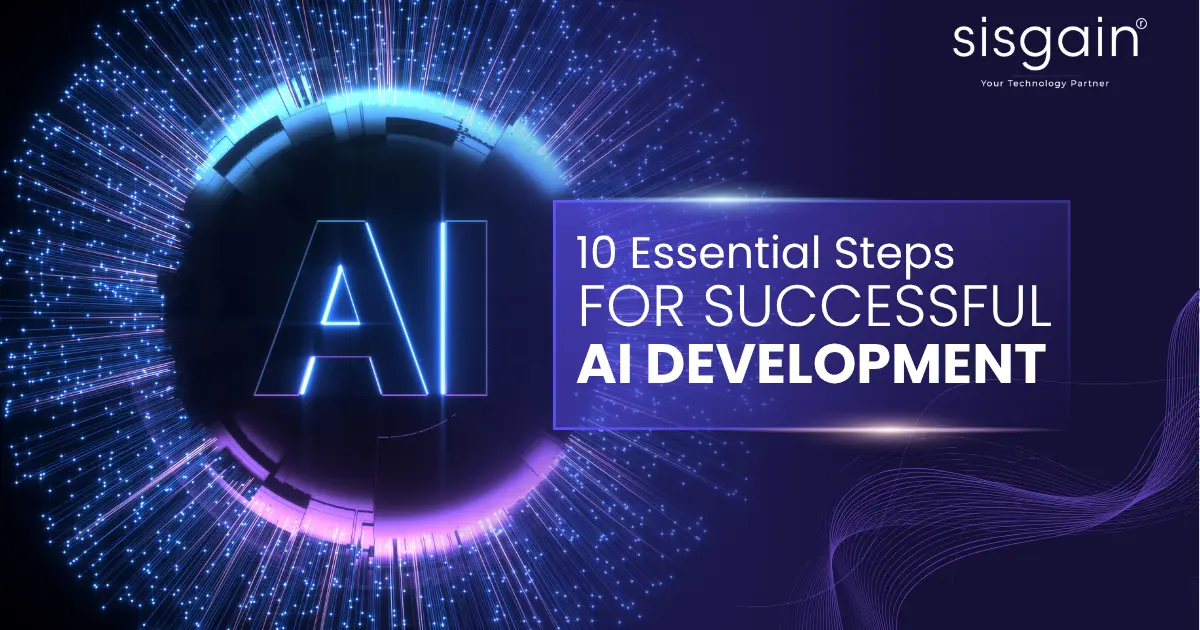Sales Team
Project quotes, partnerships, implementation

Artificial Intelligence (AI) is transforming the world as we know it. From automating mundane tasks to providing actionable insights, AI enables businesses to innovate and stay competitive. But achieving successful AI implementation is not just about installing a system; it requires a structured, strategic approach. In this blog, we will walk you through 10 essential steps for successful AI development, highlighting the AI development process, AI model development process, and how businesses can excel in developing artificial intelligence.
Whether you are wondering “what is the first step in the process of AI” or exploring how to develop artificial intelligence, this comprehensive guide will answer all your questions and provide actionable steps for your AI journey.
The very first step in the AI development process is understanding the problem you want to solve. Clear objectives form the foundation of your AI project and ensure that your AI solution delivers real business value.
Steps to define objectives effectively:
Identify the business problem: Pinpoint the process inefficiency, challenge, or opportunity that AI will address, such as automating repetitive tasks, improving customer support, or predicting trends.
Set measurable goals: Determine the outcomes you want to achieve, like improved accuracy, reduced operational costs, enhanced efficiency, or increased customer satisfaction.
Clarify the process: Ask questions such as “what is the first step in the process of AI” to ensure all stakeholders have a shared understanding of the project’s purpose.
By following these steps, businesses can ensure that their AI initiatives are well-aligned with organizational priorities. Establishing precise objectives helps guide the selection of suitable technologies, algorithms, and strategies. This approach allows teams to develop an AI solution that is practical, effective, and capable of delivering measurable results, ultimately transforming business operations and supporting strategic goals.
Data is the backbone of AI, and the AI model development process cannot succeed without accurate, relevant, and comprehensive datasets. The quality and quantity of data directly influence how well an AI system can learn, make predictions, and provide actionable insights. High-quality data ensures that AI models perform reliably and deliver meaningful outcomes.
Key steps in data preparation:
Data Collection: Gather both structured and unstructured data from a variety of sources, including internal databases, external datasets, web APIs, or IoT devices. Collecting diverse and representative data is crucial for building robust AI models.
Data Cleaning: Ensure the dataset is reliable by removing errors, duplicates, inconsistencies, and irrelevant information. Clean data prevents biases and inaccuracies that could negatively impact model performance.
Data Labeling: For supervised learning tasks, annotate the data properly so that the AI system can recognize patterns effectively. Accurate labeling is essential for tasks like image recognition, natural language processing, and predictive analytics.
Properly prepared data forms the foundation for developing artificial intelligence solutions. Without high-quality, well-structured data, even the most advanced AI algorithms can fail to deliver accurate predictions. By investing time in data collection, cleaning, and labeling, organizations can ensure their AI models are reliable, effective, and capable of driving real business value.
Selecting the right tools and frameworks is a critical step in the AI development process. The technology stack you choose determines how efficiently your AI system can be developed, deployed, and maintained. Using appropriate frameworks and platforms not only accelerates development but also ensures scalability, reliability, and seamless integration with existing business systems.
Key considerations for selecting tools:
Frameworks: Utilize machine learning and deep learning frameworks such as TensorFlow, PyTorch, or Scikit-learn based on the specific requirements of your project. The choice of framework impacts model flexibility, training speed, and ease of experimentation.
Platforms: Cloud-based AI platforms like AWS AI, Google Cloud AI, and Azure AI provide scalable infrastructure, pre-built AI services, and easy integration with other enterprise systems. These platforms help streamline deployment and reduce infrastructure overhead.
Specialized Tools: Incorporate additional tools that support the AI model development process, including data preprocessing, model monitoring, and automated deployment pipelines. Specialized tools help maintain performance, accuracy, and reliability over time.
Understanding how to create an AI system begins with choosing technology that aligns with your goals. A well-selected tech stack ensures smooth execution, efficient development, and a scalable foundation for building and maintaining AI solutions that drive measurable business value.

A strong AI model architecture forms the backbone of developing AI systems. It determines how efficiently the AI system can learn patterns from data, make predictions, and scale as business needs grow. A well-structured architecture is essential for ensuring that the AI model performs reliably and adapts to changing data and operational requirements.
Key steps in designing AI model architecture:
Choose the Type of AI Model: Decide whether your solution requires supervised learning, unsupervised learning, or reinforcement learning. The choice depends on your problem type, data availability, and the desired outcomes.
Select Appropriate Algorithms: Based on your use case, select algorithms that best suit your objectives. Options include neural networks for deep learning, decision trees for classification tasks, support vector machines for structured data, or ensemble models for improving accuracy.
Plan for Integration and Scalability: Design the model so it can seamlessly integrate with existing business systems and handle growing data volumes. Scalability ensures that the AI system remains effective as your organization expands.
Focusing on model architecture allows businesses to develop an AI model that is both efficient and reliable. A thoughtfully designed AI architecture ensures high performance, reduces errors, and provides a strong foundation for deployment, maintenance, and future enhancements in the AI lifecycle.
Training is the most critical phase in developing artificial intelligence. This stage enables the AI model to learn patterns from the prepared data, recognize relationships, and make accurate predictions. Proper training ensures that the AI system performs reliably in real-world scenarios and delivers actionable insights that support decision-making.
Key steps in training the AI model:
Dataset Splitting: Divide the data into training, validation, and test sets. The training set allows the model to learn patterns, the validation set helps tune parameters, and the test set evaluates performance on unseen data.
Model Training: Feed the training data into the model and adjust parameters iteratively. During this process, the model gradually improves its predictions by learning from errors and refining its internal representations.
Optimization Techniques: Use techniques like gradient descent, backpropagation, or other optimization algorithms to minimize errors and enhance model performance. These methods help the AI system converge toward optimal solutions efficiently.
Training is directly connected to how to create an AI algorithm, as it transforms raw data into predictive capabilities. A well-trained model is accurate, reliable, and capable of generating insights that can drive business growth. Investing time in proper training ensures your AI system performs effectively and meets organizational goals.
Validation is a critical step in the AI development process that ensures the model performs effectively not just on the training data but also on new, unseen datasets. This step is essential to verify that the AI system can generalize well, avoid errors, and provide reliable results in real-world applications. Fine-tuning the model further enhances its performance, making it more accurate, robust, and aligned with business objectives.
Key steps in validation and fine-tuning:
Adjust Hyperparameters: Modify key parameters of the model, such as learning rate, number of layers, or regularization strength, to improve accuracy and efficiency. Hyperparameter tuning allows the model to better capture patterns in the data.
Use Cross-Validation: Implement cross-validation techniques to prevent overfitting, where the model learns the training data too well, or underfitting, where it fails to capture patterns. This ensures a balanced, reliable performance.
Incorporate Expert Feedback: Engage domain experts to review predictions and provide insights. Expert input can help refine the model and improve its ability to handle complex scenarios.
This phase is vital for how to develop an AI model, as it ensures the system is reliable, scalable, and ready for deployment in real-world scenarios. Proper validation and fine-tuning increase confidence in the AI system’s predictions and overall effectiveness.
Deployment is the stage where your AI model moves from being a prototype to a fully functional system that operates in real-world conditions. Knowing how to build an AI system effectively requires careful planning, integration, and monitoring. Proper deployment ensures that the AI delivers real value to the business and performs reliably under live conditions.
Key steps for successful AI deployment:
Integrate with Existing Systems: Connect the AI model with your current applications, workflows, and databases. This ensures the system works seamlessly within your business environment.
Handle Real-Time Data: Make sure the AI system can process incoming data in real time and generate predictions quickly and accurately. This is crucial for applications like customer support, recommendation engines, or fraud detection.
Continuous Monitoring: Keep track of the AI system’s performance to spot any errors, anomalies, or drops in accuracy. Monitoring allows you to address issues quickly and maintain consistent performance.
By following these steps, businesses can ensure their AI system operates efficiently, adds measurable value, and scales as needed. Proper deployment bridges the gap between development and real-world application, making the AI model an effective tool for decision-making and business growth.

AI models are not “set and forget” systems; they require ongoing oversight to remain effective and reliable. This process is often referred to as AI expert pour maintenance, and it is essential for ensuring that AI systems continue to deliver accurate predictions and insights over time. Proper monitoring and maintenance help prevent errors, bias, and performance degradation, which can occur as data patterns change or as the system is exposed to new scenarios.
Key steps in monitoring and maintaining AI models:
Track Model Performance: Continuously monitor the AI system to ensure consistent accuracy and reliability. Regular performance tracking helps detect issues early before they impact business decisions.
Update with New Data: AI models must be retrained periodically with fresh and relevant data. This keeps them accurate and aligned with changing trends or evolving business needs.
Address Model Issues: Actively check for challenges like model drift, bias, or declining performance. Taking corrective action ensures the AI system remains fair, precise, and trustworthy.
Maintenance is a critical part of developing AI, as it ensures long-term efficiency and dependability. By investing in regular oversight, businesses can maximize the value of their AI systems and ensure that the technology continues to support strategic objectives effectively.
Ethical AI is an essential part of the AI steps and plays a critical role in building trust and credibility in AI systems. Responsible AI focuses on ensuring fairness, transparency, and privacy while making decisions. Without proper ethical practices, AI systems can unintentionally create biases, violate privacy, or make decisions that harm users or organizations. Incorporating ethics into AI development ensures that the technology is not only effective but also socially responsible.
Key steps for implementing ethical AI:
Protect User Data: Ensure that personal and sensitive information is secured. Follow data privacy regulations like GDPR and HIPAA to maintain legal compliance and protect user trust.
Conduct Bias Audits: Regularly evaluate AI models to detect and address any biases or unfair outcomes. Audits help ensure that AI systems make decisions fairly and do not discriminate against any group.
Maintain Transparency: Make AI decision-making processes understandable to stakeholders. Providing clear explanations about how predictions or recommendations are made enhances user confidence.
Adopting ethical practices is crucial in how to develop artificial intelligence responsibly. By prioritizing fairness, transparency, and privacy, businesses can build AI systems that users trust, comply with regulations, and align with global standards. Ethical AI ensures long-term success and sustainability of AI initiatives.
Once an AI system is successfully deployed, the next crucial step is scaling it to maximize its impact across the organization. Scaling ensures that AI initiatives continue to deliver significant value, support strategic goals, and remain competitive in a rapidly evolving business landscape. Expanding AI capabilities allows organizations to leverage insights across multiple departments and processes, enhancing overall efficiency and decision-making.
Key steps to scale and improve AI systems:
Expand Across Departments: Apply AI solutions to new areas of the business, such as marketing, operations, supply chain, or customer service. Broad adoption allows organizations to derive more value from their AI investments.
Leverage Cloud and Distributed Computing: Utilize cloud infrastructure and distributed computing systems to process larger datasets and handle complex computations efficiently. This ensures that AI systems remain scalable as data volumes grow.
Innovate Continuously: Keep exploring advanced techniques, new algorithms, and emerging technologies to create a next-generation AI platform. Continuous innovation helps organizations stay ahead in AI adoption.
By following these steps, businesses can ensure that their AI systems not only maintain high performance but also evolve to meet future challenges. Scaling and improving AI solutions solidifies their long-term impact and transforms AI from a single project into a strategic organizational asset.
Developing AI can be complex, but with the right partner, businesses can navigate this journey successfully. SISGAIN provides expert support at every stage of the AI development process, from planning to maintenance.
SISGAIN, as part of Artificial Intelligence Services Companies, provides end-to-end AI solutions that help businesses integrate intelligent systems into workflows, improving efficiency, optimizing operations, and enabling better decision-making. Their expertise ensures AI initiatives align with organizational goals while delivering measurable results.
Through Agentforce, SISGAIN applies AI in sales and CRM systems, automating repetitive tasks, enhancing customer engagement, and providing actionable insights to streamline sales processes and boost productivity.
With their AI Development Services, SISGAIN specializes in building custom AI models, deploying AI systems, and providing ongoing AI expert pour maintenance, ensuring solutions remain accurate, scalable, and continuously aligned with business requirements.
By partnering with SISGAIN, businesses can develop an AI, understand how to create an AI system, and build artificial intelligence software tailored to their specific needs. SISGAIN ensures best practices in the AI model development process, ethical AI deployment, and continuous improvement. This makes them a trusted choice for businesses looking to excel in developing AI.
The journey of AI development involves multiple steps, from understanding the problem to continuous monitoring and scaling. By following these 10 essential steps, businesses can successfully develop an AI model, create reliable AI systems, and achieve measurable outcomes.
Partnering with experienced providers like SISGAIN ensures guidance through every stage of the AI development process. Their expertise in Artificial Intelligence Services Companies, Agentforce, and AI Development Services enables businesses to unlock the full potential of AI. Explore SISGAIN’s AI offerings today and take the first step toward creating intelligent, future-ready solutions.
Project quotes, partnerships, implementation
Open roles, referrals, campus hiring